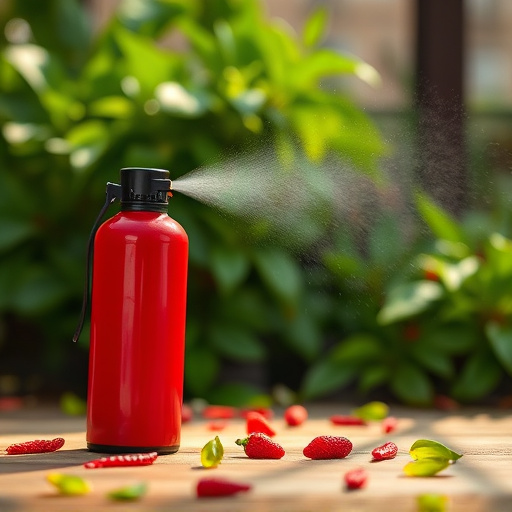Choosing between bear spray and personal pepper spray depends on context: bear spray for outdoor wildlife threats with higher capsaicin concentration and wide nozzle; personal pepper spray for human self-defense in close quarters with lower concentration and precise stream. Select based on threat, environment, and legal implications, ensuring proper training for responsible use. (SEO keywords: Bear Spray Vs Personal Pepper Spray)
“Staying safe while out and about is paramount, especially with unpredictable encounters on the horizon. This guide delves into the world of self-defense weapons, focusing on the nuances between bear spray and personal pepper spray. Understanding these distinct types is crucial for effective protection. We’ll explore their unique features, design differences, and how to choose the ideal spray tailored to your needs. Additionally, learn about proper use techniques and training considerations to ensure your safety in various situations.”
- Understanding Pepper Spray Types: Bear vs Personal
- Safety Features and Differences in Design
- Choosing the Right Spray for Your Needs
- Effective Use and Training Considerations
Understanding Pepper Spray Types: Bear vs Personal
When it comes to self-defense, understanding the difference between bear spray and personal pepper spray is crucial. Bear spray, designed for deterring bears, is more potent and often contains capsaicin in concentrations ranging from 2% to 4%. It’s formulated to create a large aerosol mist that can be effective at a greater range than personal pepper spray. Personal pepper spray, on the other hand, is tailored for human-to-human interactions and typically has a lower concentration of capsaicin, around 10% or less. This lower concentration ensures it causes temporary blindness and discomfort without posing significant risk to bystanders or causing long-term harm.
The key distinction lies in their applications. Bear spray is ideal for outdoor activities in bear country, providing a wider reach and stronger sting to deter aggressive wildlife. Personal pepper spray, however, is more suitable for close-quarters self-defense scenarios against humans, offering a swift and effective means of incapacitation without the risk of permanent damage. Knowing these differences enables users to choose the right tool for their specific needs, enhancing safety and effectiveness in potential confrontation situations.
Safety Features and Differences in Design
When considering bear spray vs personal pepper spray for self-defense, understanding their safety features and design differences is key. Bear spray, designed to deter large wildlife like bears, typically has a wide range and higher concentration of capsaicin, often around 2% or more. This high concentration can cause severe pain and temporary blindness even at close ranges, making it effective against aggressive animals but potentially dangerous for human-on-human encounters.
In contrast, personal pepper spray is tailored for self-defense scenarios against humans. It usually has a lower capsaicin concentration, around 1-2%, and is designed to provide a targeted, non-lethal force. The design differences also include factors like nozzles, range, and ease of use. Bear spray often features a wide nozzle for maximum coverage, while personal pepper spray may have a more precise stream nozzle for direct application on the attacker’s face. These variations highlight the need to choose the right self-defense tool based on the specific threat and environment.
Choosing the Right Spray for Your Needs
When considering pepper spray as a self-defense tool, one of the primary decisions is choosing between bear spray and personal pepper spray. Each has distinct purposes and applications. Bear spray, designed to deter bears, is more potent and often used in outdoor activities like hiking or camping where larger animals pose a threat. It’s effective at longer ranges and can be useful for repelling aggressive wildlife.
Personal pepper spray, on the other hand, is tailored for self-defense against humans. It’s generally less potent but provides close-range protection in urban settings. The shorter effective range makes it ideal for personal safety in crowded areas or during unexpected attacks. Consider your environment and potential threats to select the right spray that aligns with your needs, ensuring you’re prepared for any situation.
Effective Use and Training Considerations
When considering pepper spray for self-defense, understanding the differences between bear spray and personal pepper spray is key. While both aim to incapacitate an assailant through irritation, they serve distinct purposes. Bear spray, designed for wildlife encounters, offers a wider range and higher potency, ideal for outdoor threats. In contrast, personal pepper spray focuses on close-quarters defense, typically used indoors or in more confined spaces.
Effective use requires proper training. Users should learn the correct application technique—aiming for the face and eyes—to ensure maximum effectiveness while minimizing accidental exposure. Regular practice sessions are crucial, especially for individuals with limited mobility or those facing potential threats regularly. Training should cover not just the physical act of spraying but also de-escalation tactics and understanding legal implications to use pepper spray responsibly and within legal boundaries.
When considering pepper spray as a self-defense tool, understanding the distinctions between bear spray and personal pepper spray is paramount. Both serve vital purposes, but their design and effectiveness differ significantly. By choosing the right spray tailored to your needs and ensuring proper training in its effective use, you can enhance your safety and peace of mind in potentially dangerous situations. Remember, knowledge is power, and being prepared can make all the difference.
